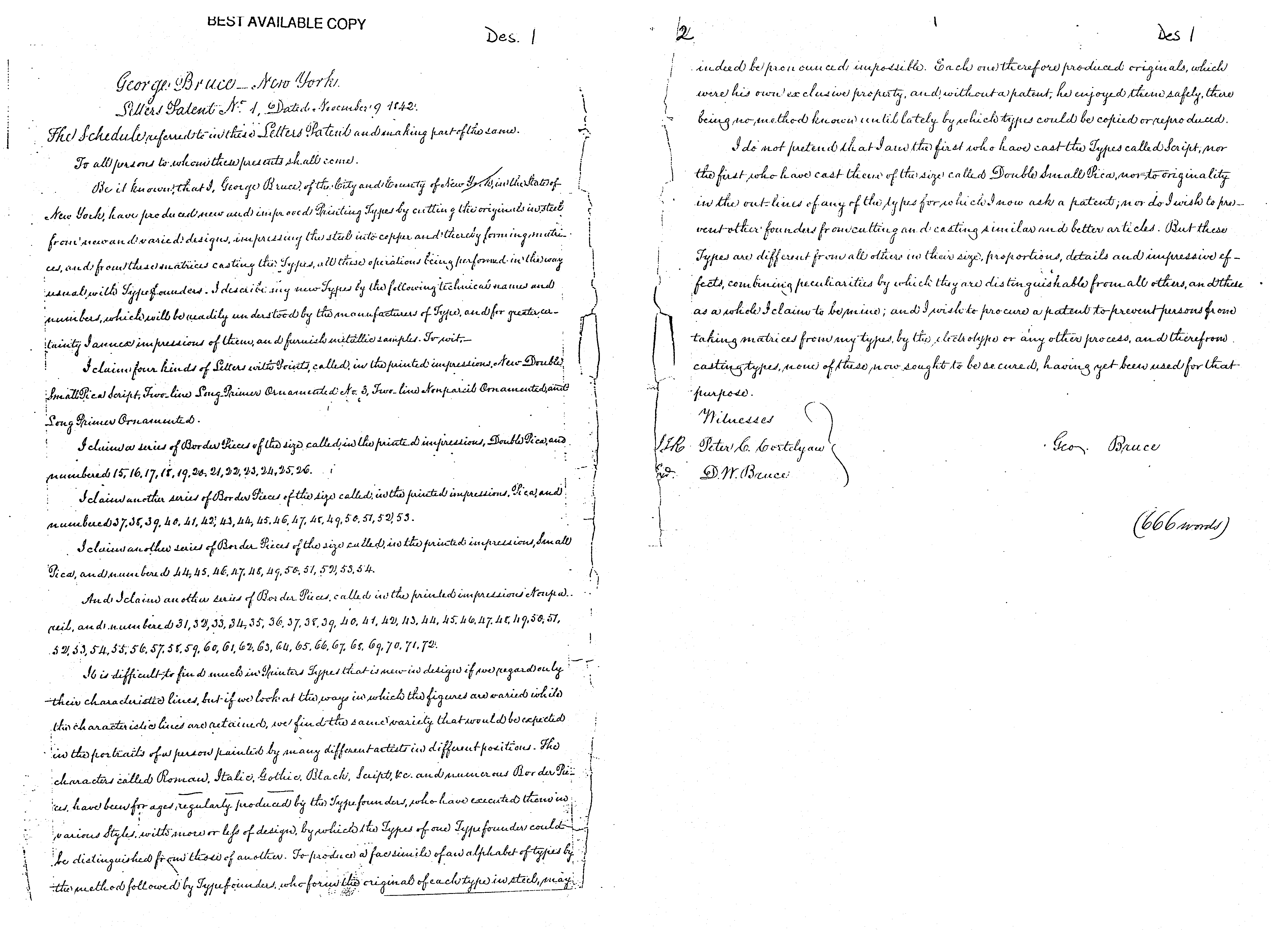Des. 1
George Bruce – New York.
Letters Patent No. 1, Dated November 9, 1842.
The Schedule referred to in these Letters Patent and making part of the same.
To all persons to whom these presents shall come,
Be it known that I, George Bruce of the City and County of New York, in the State of New York, have produced new and improved Printing Types by cutting the originals in steel from new and varied designs, impressing the steel into copper and thereby forming matrices, and from these matrices casting the Types, all these operations being performed in the way usual with Typefounders. I describe my new Types by the following technical names and numbers, which will be readily understood by the manufacturers of Type, and for greater certainty I annex impressions of them, and furnish metallic samples. To wit.—
I claim for kinds of Letters with Points, called in the printed impressions, New Double Small Pica Script, Two-line Long Primer Ornamented No. 3, Two-line Nonpareil Ornamented, and Long Primer Ornamented.
I claim a series of Border Pieces of the size called in the printed impressions, Double Pica, and numbered 15, 16, 17, 18, 19, 20, 21, 22, 23, 24, 25,26.
I claim another series of Border Pieces of the size called in the printed impressions, Pica, and numbered 37, 38, 39, 40, 41, 42, 43, 44, 45, 46, 47, 48, 49, 50, 51, 52, 53.
I claim another series of Border Pieces of the size called in the printed impressions, Small Pica, and numbered 44, 45, 46, 47, 48, 49, 50, 51, 52, 53, 54.
And I claim another series of Border Pieces called in the printed impressions, Nonpareil, and numbered 31, 32, 33, 34, 35, 36, 37, 38, 39, 40, 41, 42, 43, 44, 45, 46, 47, 48, 49, 50, 51, 52, 53, 54, 55, 56, 57, 58, 59, 60, 61, 62, 63, 64, 65, 66, 67, 68, 69, 70, 71, 72.
It is difficult to find much in Printers Types that is new in design if we regard only their characteristic lines, but if we look at the ways in which the figures are varied while the characteristic lines are retained, we find the same variety that would be expected in the portraits of a person painted by many different artists in different positions. The characters called Roman, Italic, Gothic, Black, Script, &c. and numerous Border Pieces have been for ages regularly produced by the Typefounders, who have executed them in various Styles with more or less of design, by which the Types of one Typefounder could be distinguished from those of another. To produce a facsimile of an alphabet of types by the method followed by Typefounders who form the original of each type in steel, may indeed be pronounced impossible. Each one therefore produced originals, which were his own exclusive property, and without a patent, he enjoyed them safely, there being no method known until lately by which types could be copied or reproduced.
I do not pretend that I am the first who have cast the Types called Script, nor the first who have cast those of the size called Double Small Pica, nor to originality in the outlines of any of the type for which I now ask a patent nor do I wish to prevent other founders from cutting and casting similar and better articles. But these Types are different from all others in their size, proportions, details, and impressive effects, combining peculiarities by which they are distinguishable from all others, and these as a whole I claim to be mine; and I wish to procure a patent to prevent persons from taking matrices from my types by the electrotype or any other process, and therefrom casting types, none of these now sought to be cured, having yet been used for that purpose.
George Bruce
Witnesses
Peter C. Cortelyou
D.W. Bruce
(666 words)
